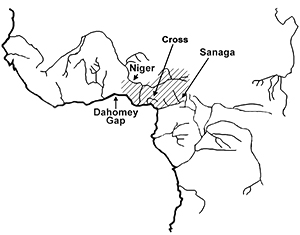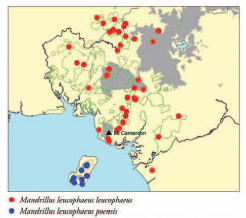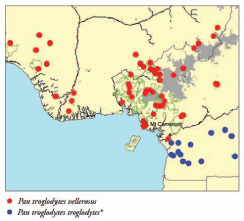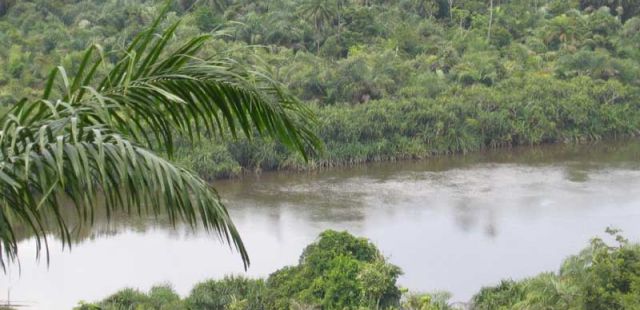Rivers and Wildlife
The Nigeria-Cameroon forest region is best defined by its rivers. For wildlife, rivers can be a barrier to movement.
A species on one side of a large river may differ from a different subspecies or closely related species found on the other side of the river.
There are three very important rivers for the Nigeria-Cameroon Chimpanzee and the Drill. These are the Sanaga River, the Niger River, and the Cross River.
 In Cameroon, the Sanaga River is a large, major river that bisects the country and acts as a boundary to wildlife between Northern and Southern Cameroon. South of the Sanaga River are the Atlantic Equatorial Coastal Forests (in Southern Cameroon, Gabon, Equatorial Guinea) and the Congo basin forests. To the West, the Niger River defines the Nigeria-Cameroon area as distinct from the Upper Guinea forests. Between the Niger and the Sanaga Rivers, the region is called the 'Lower Guinean forests', but may also be referred to as the Bight of Biafra forests, or the Nigeria-Cameroon border region.
In Cameroon, the Sanaga River is a large, major river that bisects the country and acts as a boundary to wildlife between Northern and Southern Cameroon. South of the Sanaga River are the Atlantic Equatorial Coastal Forests (in Southern Cameroon, Gabon, Equatorial Guinea) and the Congo basin forests. To the West, the Niger River defines the Nigeria-Cameroon area as distinct from the Upper Guinea forests. Between the Niger and the Sanaga Rivers, the region is called the 'Lower Guinean forests', but may also be referred to as the Bight of Biafra forests, or the Nigeria-Cameroon border region.
In the middle of this Nigeria-Cameroon forest area, about halfway between the Sanaga and the Niger rivers, is a large river called the Cross River. The Cross River is also a barrier to a number of species, including the drill, which is endemic to the area between the Cross and the Sanaga. There are a number of species, especially primates, found only in this region. The forest from the Cross River to the Sanaga River is referred to as the Cross-Sanaga region.
Each river in this Nigeria-Cameroon region is part of important watershed, running through savanna to the north, and then through the forests before reaching the ocean and emptying into the Gulf of Guinea. Watersheds are important for the health of the environment.
Rivers as geographic Barriers to Species
The area of interest to Tengwood.org stretches from the Niger River (in Nigeria) to the Sanaga River (in Cameroon), and contains a fauna and flora that is unique. While some species in these forests are found in other Equatorial African forests, other species are found nowhere else on the African continent or in the world. The Niger, Sanaga and Cross Rivers are very large and act as geographic barriers to some mammals. The Sanaga River, in particular, divides a number of closely related primate species from one another.
Drill Barriers - The Sanaga and Cross Rivers
 Primate populations that could not cross the large Sanaga river diverged from one another over evolutionary time. The best example of this divergence is the genus Mandrillus, which consists of only two species, the drill and the mandrill. North of the Sanaga is drill habitat, while south is mandrill habitat. These two species are more similar to one another than they are to any other primate, but as appearances go, they also have some very distinct differences! In the West, the drill is limited by the Cross River.
Primate populations that could not cross the large Sanaga river diverged from one another over evolutionary time. The best example of this divergence is the genus Mandrillus, which consists of only two species, the drill and the mandrill. North of the Sanaga is drill habitat, while south is mandrill habitat. These two species are more similar to one another than they are to any other primate, but as appearances go, they also have some very distinct differences! In the West, the drill is limited by the Cross River.
Nigeria-Cameroon Chimp Barriers-The Niger and Sanaga Rivers
 The Sanaga also separates the two Western Chimpanzee populations (Pan troglodytes verus and Pan troglodytes ellioti) from those in Central (Pan troglodytes troglodytes) and East Africa (Pan troglodytes schweinfurtii). Unlike the drill, however, the ellioti chimpanzee (in this map, both Western chimp subspecies are listed under 'vellerosus') is found on both sides of the Cross River. The western boundary of P. t. ellioti is thought to be the Niger River, but this is not yet clearly defined. In surveys that looked at wildlife in Southwestern Nigerian forests, chimps were difficult to find and for researchers defining the ellioti subspecies, DNA samples from chimps living west of the Niger River and into Ghana were not available for analysis.
The Sanaga also separates the two Western Chimpanzee populations (Pan troglodytes verus and Pan troglodytes ellioti) from those in Central (Pan troglodytes troglodytes) and East Africa (Pan troglodytes schweinfurtii). Unlike the drill, however, the ellioti chimpanzee (in this map, both Western chimp subspecies are listed under 'vellerosus') is found on both sides of the Cross River. The western boundary of P. t. ellioti is thought to be the Niger River, but this is not yet clearly defined. In surveys that looked at wildlife in Southwestern Nigerian forests, chimps were difficult to find and for researchers defining the ellioti subspecies, DNA samples from chimps living west of the Niger River and into Ghana were not available for analysis.
























